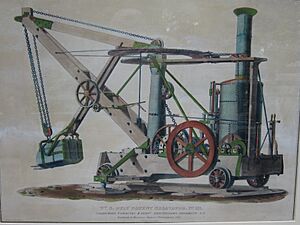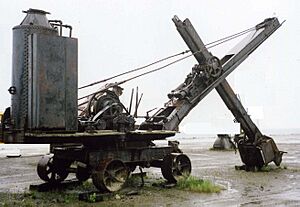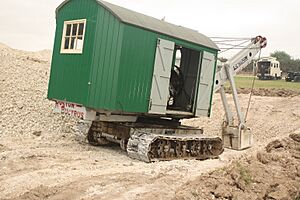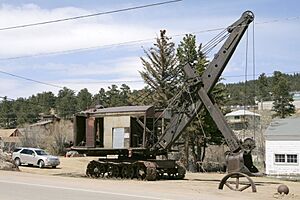Steam shovel facts for kids
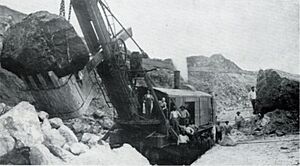
A steam shovel is a very large machine that uses steam power to dig and move things like rocks and soil. It was the first type of power shovel or excavator. Steam shovels were super important for big building projects in the 1800s and early 1900s. They helped build railroads and the famous Panama Canal. But after the 1930s, newer, cheaper machines that ran on diesel, gasoline, or electricity took their place.
Contents
History of Steam Shovels
How Steam Shovels Started
The very first idea for a steam-powered digging machine came from Grimshaw of Boulton & Watt in 1796. Then, in 1833, William Brunton patented another design. But the steam shovel we know was truly invented by William Otis. He got a patent for his design in 1839.
The first steam shovels could only swing their digging arm part of the way around, not a full 360 degrees. They were built on a railway chassis, which is like a train car. The engine and boiler were on this chassis. Workers had to lay temporary train tracks for the shovel to move on.
Later on, things got easier! In the 1870s, steel cables made it simpler to connect the shovel arm to the winches (the parts that pull the cables). Even better, some machines later got caterpillar tracks, like tanks, so they didn't need rails anymore.
In 1884, a new design came out in England. This shovel could spin its digging arm all the way around (360 degrees). This became the best way to build these machines.
Steam Shovels at Work
As railways grew in places like the US and the UK, there was a huge need for steam shovels. They had to move so much dirt and rock to build all those tracks! This made steam shovels very common.
Big American companies like the Marion Steam Shovel Company (started in 1884) and the Bucyrus Company made many of these machines.
In North America, growing cities used shovels to dig deep holes for the foundations of early skyscrapers.
One of the biggest jobs for steam shovels was digging the Panama Canal. Over a hundred steam shovels worked for ten years on this huge project! Seventy-seven of them were made by Bucyrus, and the rest were Marion shovels. These machines truly "moved mountains" to create the canal. The shovel crews even had races to see who could move the most dirt!
Steam shovels also helped a lot in mining. They were used in iron mines, copper mines, and even for finding gold in the Klondike. As open-pit mines (where you dig from the surface) became popular, shovels were key to removing huge amounts of earth. They were used all over the world, from Australia to Russia to China. Shovels also helped build roads, quarries, and other structures.
In the 1920s, steam shovels were very busy building thousands of miles of roads in North America. They also helped construct factories, docks, ports, and many other buildings.
What Came After Steam Shovels
After the 1930s, steam shovels started to be replaced. Newer digging machines that ran on diesel fuel were simpler and cheaper. These diesel shovels were the early versions of the excavators we see today.
Many steam shovels kept working on railways in developing countries until diesel engines took over there too. Most of them have been taken apart for scrap metal.
However, some very large mining shovels still use a similar cable-lift system. In the 1950s and 1960s, Marion Shovel built giant shovels for coal mines. Some famous ones include the Marion 360, the Marion 5900, and the biggest shovel ever built, the Marion 6360 called The Captain. It had a bucket that could hold 180 cubic yards of material! Bucyrus also built a famous giant called Big Brutus, which is still around today. Even though these huge machines are sometimes still called "steam shovels," they are actually "power shovels" because they use electricity to power their winches.
How a Steam Shovel Works

A steam shovel is made up of several main parts:
- A bucket with a toothed edge to dig into the ground.
- A dipper or dipper stick that connects the bucket to the long arm.
- A boom (the long arm) that holds the dipper and its control cables. It's mounted on a platform that can turn.
- A boiler that makes the steam.
- A water tank and a coal bunker (where the fuel is kept).
- Steam engines and winches (machines that pull cables).
- The operator's controls.
- A platform where all the parts are put together.
- Wheels (or sometimes caterpillar tracks or train wheels).
- A house on the platform to protect the machinery.
The shovel can do several things: it can lift the boom, push the dipper stick out or pull it back, and raise or lower the dipper stick. Some shovels can spin their whole platform, like modern excavators. Others only spin the boom itself.
When digging into a pile of rock or dirt, the operator pushes and lifts the dipper stick at the same time to fill the bucket. Once the bucket is full, the shovel swings around to dump the material into a train car or truck. The operator pulls a pin, the bottom of the bucket opens, and the material drops out. Then, the operator lowers the dipper stick, the bucket closes itself, and the pin locks automatically. The whole process then starts again!
Steam shovels usually needed at least three people to operate them: an engineer, a fireman (who managed the boiler), and a ground man. Moving these huge shovels was a lot of work! They had to move rails and wooden blocks, attach cables, and set up chains. On soft ground, they used large wooden mats to keep the shovel steady. The very first models couldn't move themselves, so they used their own boom to pull themselves forward!
Steam Shovel Makers
Here are some companies that made steam shovels:
North American manufacturers:
- Ball Engine Co.
- Bucyrus
- Erie
- Marion Steam Shovel Dredge Company
- Moore Speedcrane (later Manitowoc Cranes)
- Northwest Shovels
- Thew Automatic Shovel Co.
- Vulcan Iron Works

European manufacturers:
- Demag (Germany)
- Fiorentini (Italy)
- Lubecker
- Menck
- Newton & Chambers (UK)
- Orenstein and Koppel GmbH (Germany)
- Ruston & Hornsby (UK)
Power Shovel/Dragline Manufacturers
- Bucyrus International
- Insley Manufacturing Co.
- Komatsu
- Lima Locomotive Works
- Link Belt
- Marion Power Shovel
- P&H Mining Equipment
- Priestman Bros (UK)
- Ransomes & Rapier (UK)
- Ruston-Bucyrus (UK)
Preserved Steam Shovels
Most steam shovels have been taken apart for scrap metal. But a few are still around in museums or private collections.
The Le Roy Marion
The biggest steam shovel that is still complete is a Marion machine. It was built in either 1906 or 1911 and is located in Le Roy, New York. It's even listed on the National Register of Historic Places!
This machine, built in 1909, is the oldest surviving steam "navvy" (another name for a shovel) in the world. It was first used in a chalk pit in England. After the pit closed, the shovel was left behind and got covered by water. In the 1970s, during a dry period, its top could be seen sticking out of the water. A man named Ray Hooley helped rescue it and had it fully fixed up. It's now at the Vintage Excavator Trust at Threlkeld Quarry and Mining Museum in Cumbria, England, and is being restored again.
1923 Bucyrus Model 50-B
Twenty-five Bucyrus Model 50-B steam shovels were sent to the Panama Canal to help build bridges, roads, and drains, and to remove huge amounts of rock and soil. All but one of these shovels were scrapped in Panama. The one that survived was sent back to California and then to Denver. It worked in a mine near Nederland, Colorado, until 1978. This steam shovel is one of only two working Bucyrus Model 50-Bs left! It's now kept at the Nederland Mining Museum.
Northwest Model
Two old Northwest shovels are sitting abandoned in Zamora, California, next to Interstate 5.
Steam Shovels in Stories
- The classic children's book Mike Mulligan and His Steam Shovel has a steam shovel as a main character.
- In the children's book Are You My Mother? by P. D. Eastman, a steam shovel helps a little bird find its way home.
- In the Thomas & Friends TV show, there's a steam shovel named Ned. Another rail-mounted steam shovel named Marion also appears.
- In the Australian children's TV show Mr. Squiggle, Bill the Steam Shovel makes funny jokes and blows steam from his "nose" when he laughs.
- In the 1932 Laurel and Hardy film 'Their First Mistake', Stan mentions they might win a steam shovel at a bazaar.
See also


